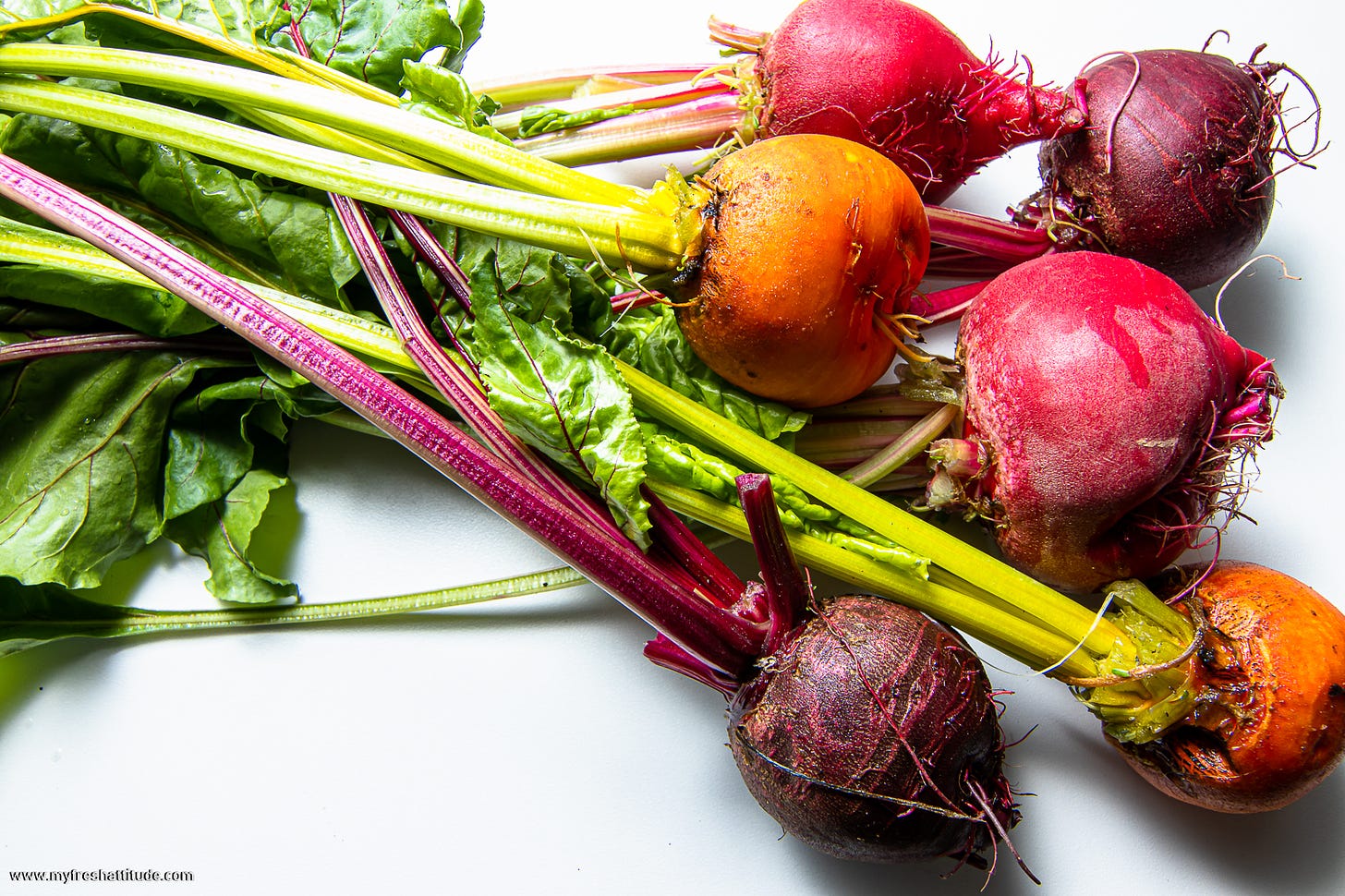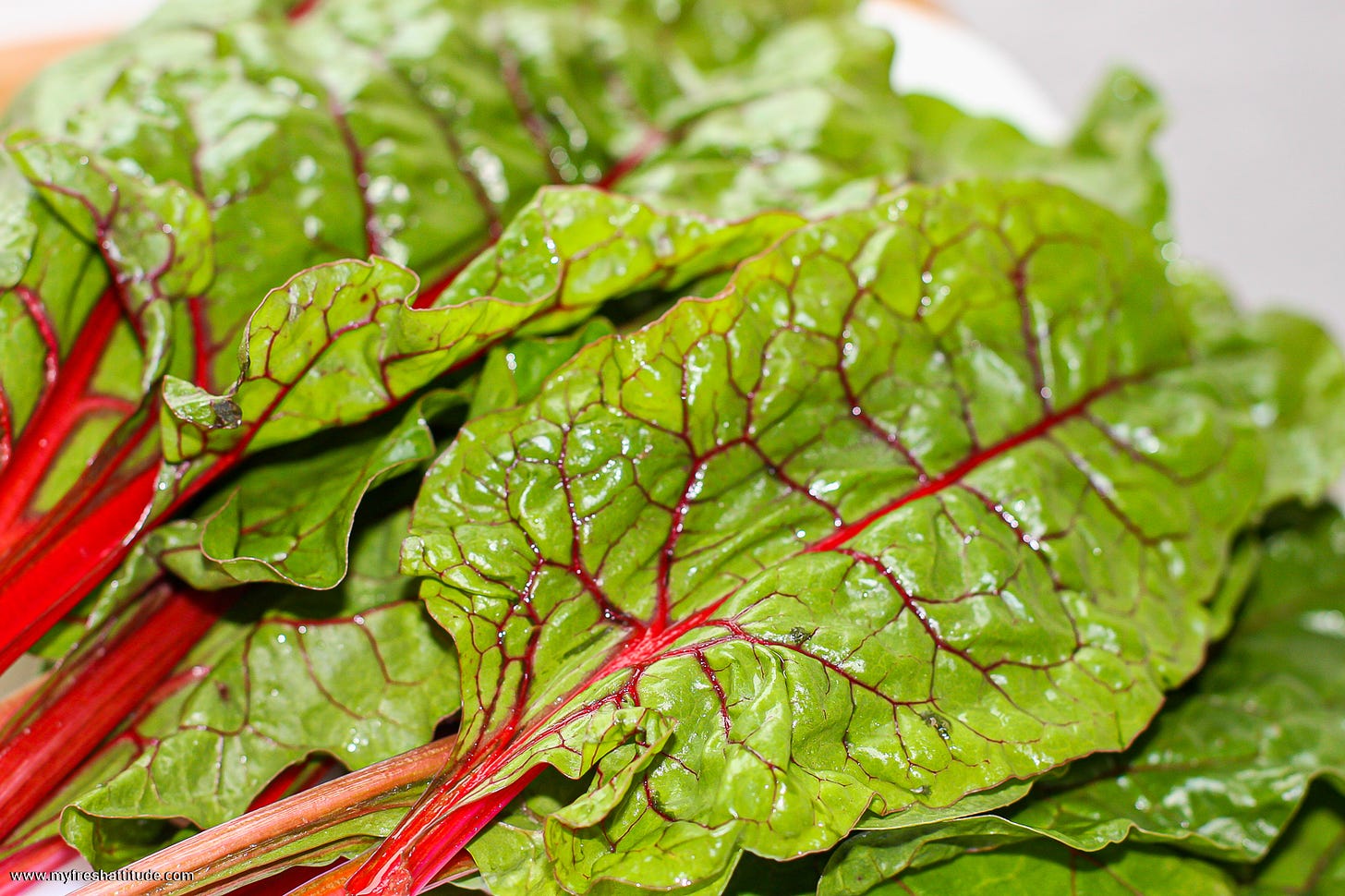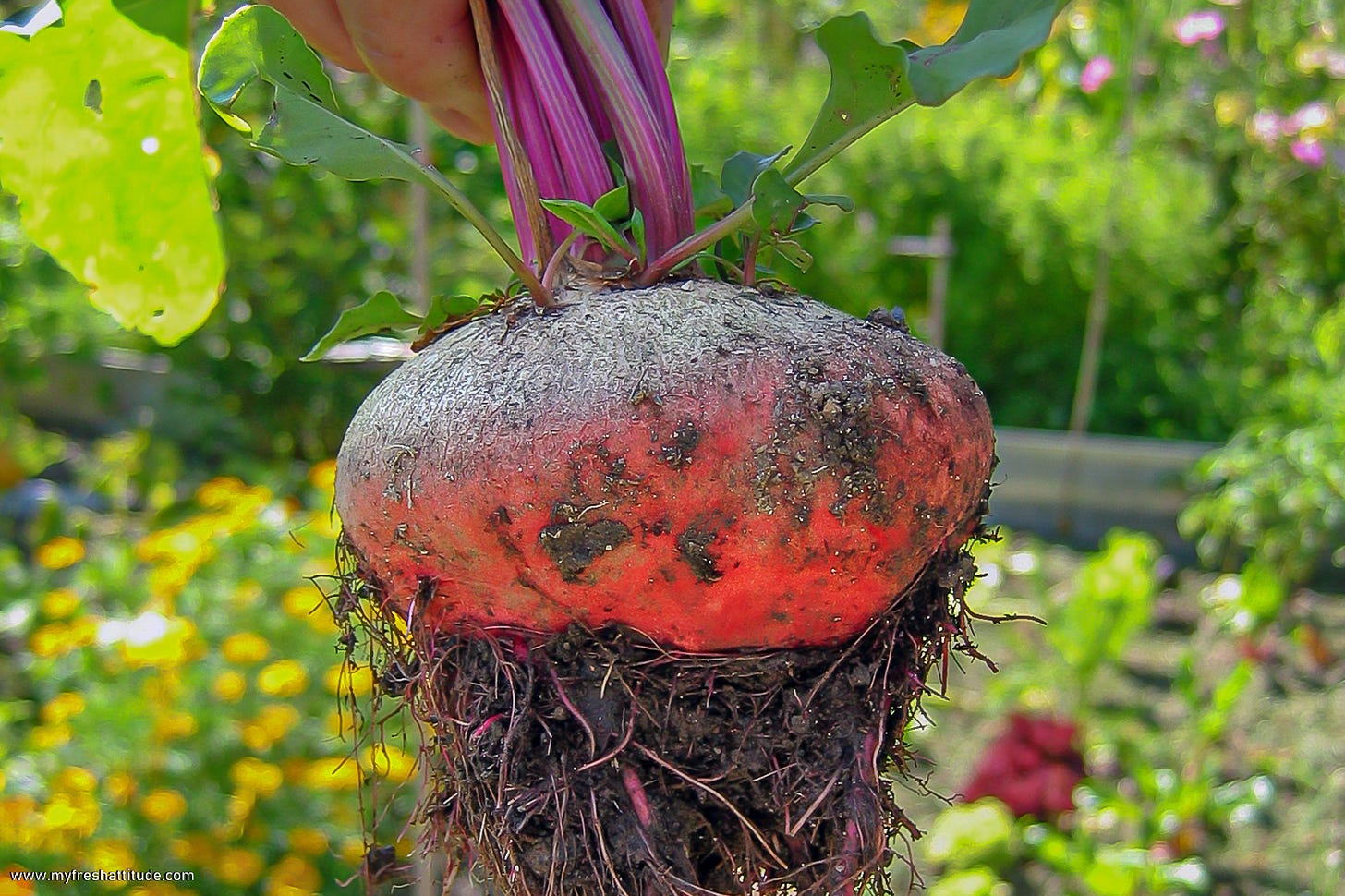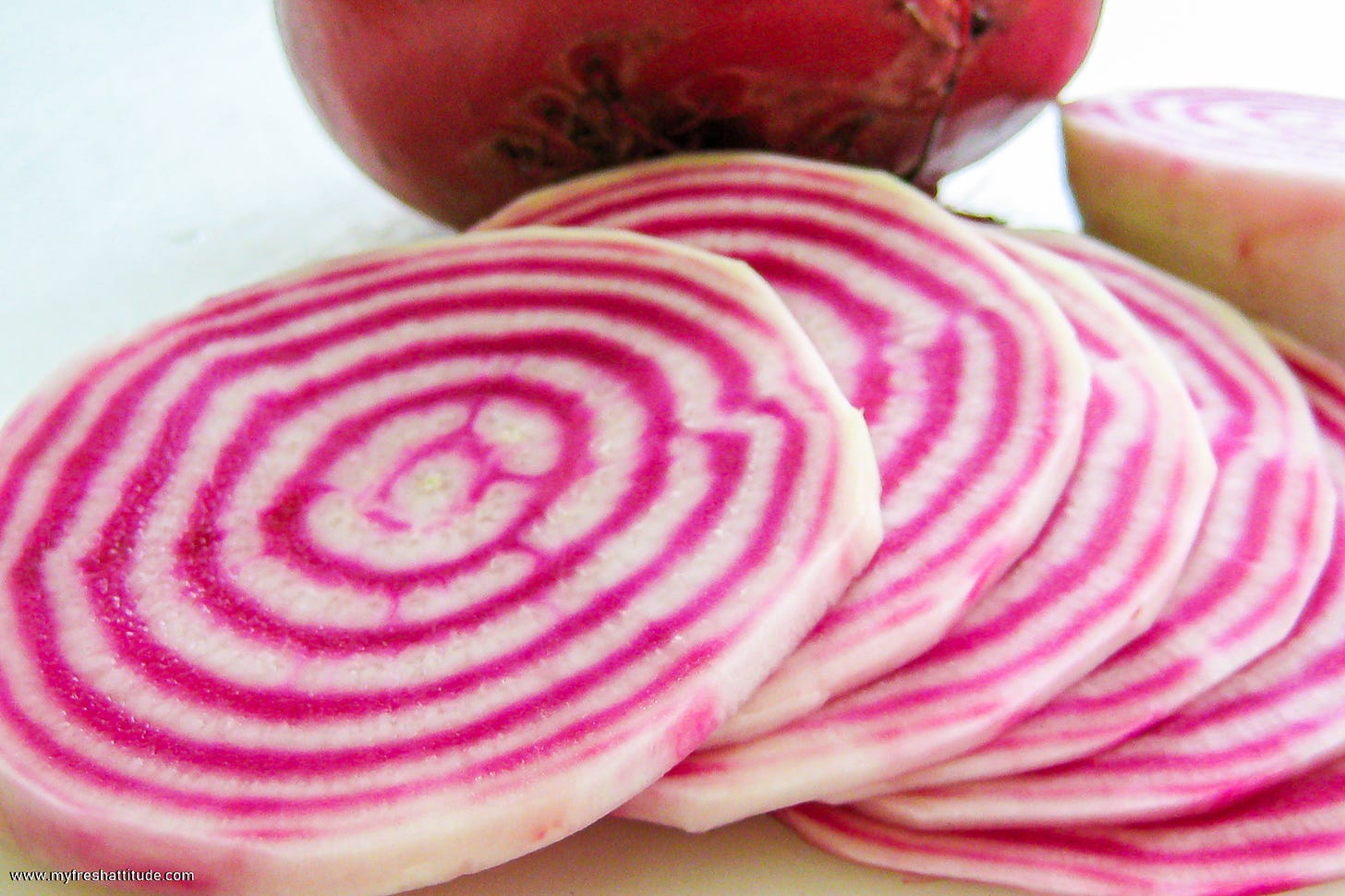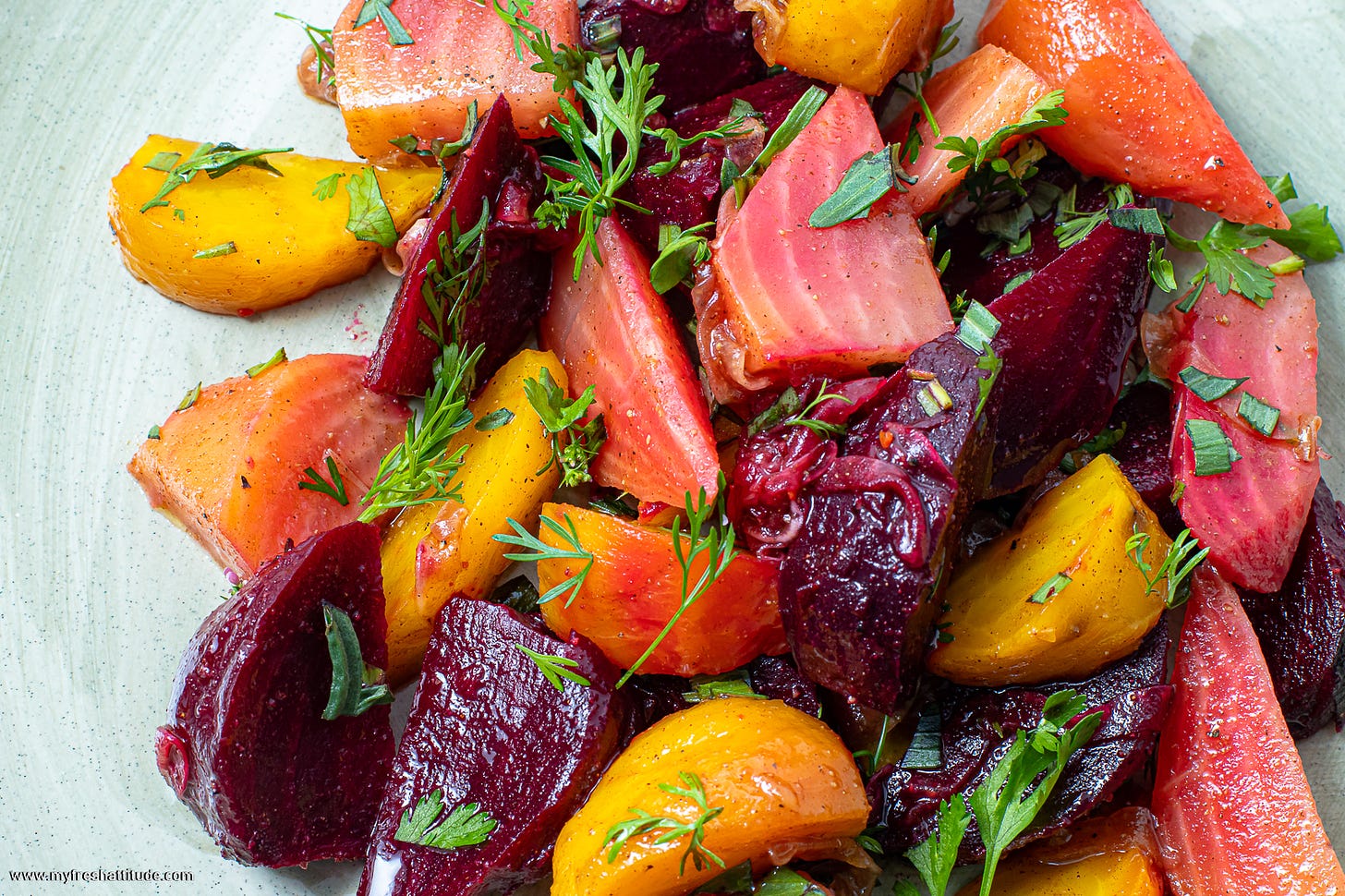Moroccan-Style Roasted Beetroot Salad
Warm Moroccan spices and a sweet-sour-spicy dressing work beautifully with earthy beetroot.
I look forward to stepping out of the tram after the short 8-minute ride that brings me to the central business district of my local community.
I enjoy seeing people moving around in every direction. I like the sounds that fill my ears – the chatter of six languages spoken by those I immediately encounter. It feels like a welcome contrast to the stoic silence inside the stale tram.
It’s still several minutes before 8 am, and I’m dodging people hurrying for work and making a late attempt at catching the tram leaving precisely on time. I see kids of all ages heading to school…and elderly people clutching their shopping carts and carefully navigating the crowded sidewalk.
I’m quickly filled with urban stress…until I round the corner and see the first market stand that lines the street and guides me toward the open plaza filled with dozens more. I throw a quick glance at the stand as I walk by – it’s a bit like watching a movie trailer to get an idea of what to expect. I don’t stop to buy anything; I’m on a mission to get to my favorite stands and see what’s on offer.
It’s early spring for me – a time of year bathed in green. I spot collard greens in bunches, dandelion greens and wild garlic, broccolini and cima di rapa, fresh broad beans and asparagus, and stacks of lettuce.
And within the sea of green, I spot early-season beetroot – tied together in a vibrant bouquet…it’s a rich kaleidoscope of colors with red, orange, yellow, and candy-striped variations. The colorful stems remain attached to the bulbs while stubbornly clutching their firm green leaves. The plant appears alive, with veins of color pushing through the leaves.
I’m convinced beetroot is one of nature’s most beautiful vegetables. I can’t wait to get hold of a couple of bunches. I can’t wait to get into the kitchen. I can’t wait to map out a plan for these beetroot – to think of something creative…and delicious.
Beetroot - A Quick Primer
Most food historians agree that beetroot probably originated during prehistoric times in North Africa, the coasts of Asia and maybe some coastal parts of Europe. The early adopters of beetroot stuck to the green bits above ground. The bulbs we enjoy today – especially the big fat deep red ones – weren’t part of the human diet until the 16th century.
Beetroot’s intense earthy flavor and rich sweetness can divide a crowd. Some adore the flavor, while others dislike…even despise…beetroot. Under-seasoning and overcooking beetroot can make them cloyingly sweet with a noticeable bitterness…a combination that won’t win many fans. But the natural sugars in beetroot can also be an advantage. Adding acids neutralizes the sugars and creates an interesting (and enjoyable) sweet-sour thing that wins over many.
This is a versatile vegetable. It can be served hot, warm, or cold. It can be cooked in many ways…or enjoyed raw, juiced or pickled.
Tip – Early beet varieties are available from early summer to the beginning of fall. Typical garden beets and sugar beets are fresh during the early fall months.
The size of beetroot is not a good indicator of how they will taste. Generally, large and small beetroot taste the same – assuming they are fresh. I prefer small beetroot for salads and larger ones if I want to include heartier chunks in a soup, salad or stew.
Try to select beetroot with firm and smooth skins that feel dense when you pick them up. Avoid the ones that are wrinkled or soft. Any attached greens (a delicious and nutritious bonus during the early season) should have firm stalks and brightly colored leaves. Small and young leaves can be added raw to a salad, while larger leaves can be sautéed like spinach, swiss chard or collard greens.
Keep beetroot refrigerated until you are ready to use them. They usually keep well for 7-14 days. Autumn varieties are more robust – they happily live in a cool, dark location for 1-2 months. Always remove any attached greens from the bulb because they pull moisture from the bulb in storage and reduce storage time.
There are many ways to cook beetroot. Boiling/steaming creates milder flavors that emphasize the earthy tones. Roasting beetroot takes a bit longer, yielding a much sweeter result (caused by the sugars caramelizing and intensifying in a hot oven). It is also possible to pressure cook, microwave (this method preserves the most nutrients), or grill beetroot on a hot BBQ – slightly smokey, grilled beetroot is simply marvelous.
Beetroot is delicious when it is sliced very thin and enjoyed raw. Use multi-colored, thinly sliced raw beetroot in a salad or served like carpaccio. Of course, beetroot is also excellent when it is juiced – often with ginger, apples and oranges.
Cooking Beetroot – A Few Guidelines
Boiling: Bring a large pot of water to a boil. Add a good amount of salt to the water once it begins to boil – try to get the water to taste a bit like seawater. Put the whole beetroot into the boiling water, cover the pot and turn the heat to medium-low. Simmer the beetroot until soft and easily pierced with a skewer or thin knife. The cooking time varies depending on the size of the beetroot but count on at least 35-45 minutes. Drain the beetroot, cool slightly and peel them while they are warm.
Steaming: Organize your steamer to sit about 5 cm (2 inches) above the water. Cover the pot and steamer and bring to a light boil. Once the steam begins to form, add the whole beetroot to the steamer. Cover and cook over steadily simmering water. The beets are cooked when soft and easily pierced with a skewer or thin knife… typically about one hour. Remove the beets from the steamer insert and cool them slightly before peeling while warm. Another important consideration – keep an eye on the water level in the steamer – it’s not good for your pot when all of the water dries up!
Roasting: Preheat the oven to 190°C (400°F) with a circulating fan. Add a bit more to the oven temperature if you do not have a circulating fan. Wash the beets, leaving a portion of the stem intact, and keep them whole and unpeeled. Rub the beetroot in some extra virgin olive oil and wrap them individually in aluminum foil (you can also add some herbs, sea salt or other flavoring agents to the packages). Place the wrapped beetroot on a rimmed baking sheet lined with some baking paper (this helps keep the baking sheet clean in case of bleeding). Roast for about 45-90 minutes – depending on the size and age of the beetroot. Ensure they are soft and easily pierced with a skewer or thin knife before removing them from the oven. Cool slightly and peel the beetroot while still warm.
Tip – I find it is best to peel beetroot once they are cooked…this minimizes bleeding and loss of nutrients during the cooking phase. Try peeling the beetroot while they are still warm – and be sure to wear gloves or use a towel. I like to peel beetroot in the sink under running water…but keep this to a minimum because you will also wash away some flavor and nutrients.
Moroccan-Style Beetroot Salad
The warm spices of Morocco and their penchant for sweet-sour-spicy flavors pair beautifully with the natural earthiness and sweetness of the beetroot. This salad represents one of my favorite ways to enjoy beetroot – especially the early season ones with their beautiful (and healthy) greens still attached.
Allow some extra time for marinating after the beets are roasted – about 60-90 minutes should be plenty.



